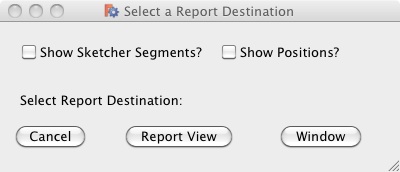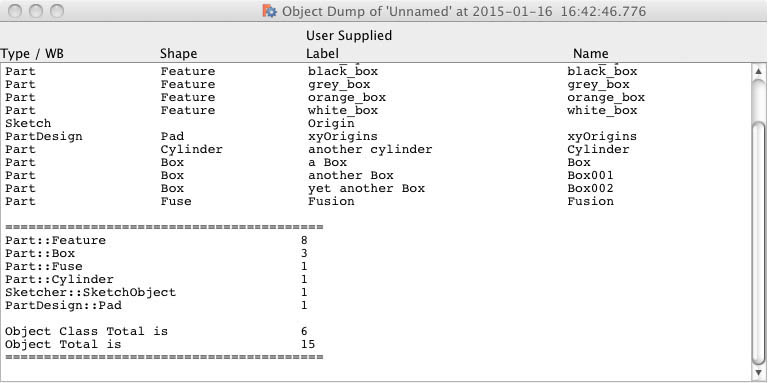|
| Descrizione |
|---|
| Questa macro genera un elenco di tutti gli oggetti del documento corrente. L'elenco può apparire nella finestra dei Rapporti o in una finestra indipendente. |
| Autore |
| Piffpoof |
| Link |
| Esempi di macro Come installare le Macro Personalizzare la barra degli strumenti |
| Versione |
| 1.0 |
| Data ultima modifica |
| 2015-03-02 |
Durante lo sviluppo di modelli complessi è facile perdere traccia di quali sono gli oggetti effettivamente presenti dato che alcuni possono essere nascosti, coperti o trasparenti. Inoltre con un gran numero di oggetti diventa necessario conservarne la traccia per gestire il sistema di denominazione.
Descrizione
Il codice Dump Object enumera tutti gli oggetti contenuti nel documento corrente. Quindi genera un rapporto che elenca ogni oggetto, poi una sintesi che fornisce il numero totale di istanze di ogni Classe, seguito dal numero totale di classi e infine il numero totale di oggetti. L'output del rapporto può essere indirizzato alla vista Report o ad una finestra indipendente. La finestra è non-modale e rimane aperta fino a quando non viene chiusa dall'utente. Ogni finestra contiene nella barra del titolo la data e l'ora in cui è stata generata, quindi si può confrontare il contenuto di più finestre, ad esempio, prima e dopo l'esecuzione di una parte di codice.
Di default sono elencati tutti gli oggetti, come opzione si può indicare anche il posizionamento di ogni oggetto. Inoltre, per gli schizzi si può elencare ogni segmento della geometria.
Installazione
Tutto il codice per dumpObject.FCMacro è contenuto nella macro. L'installazione consiste nel copiare il suo codice nella appropriata directory delle Macro. Si attiva invocando dumpObject dal menu Macro. In alternativa, può essere eseguita dalla console.
- per informazioni su come installare il codice delle macro vedere la pagina Come installare le macro
- per informazioni su come installarla abbinata a un pulsante in una barra degli strumenti vedere la pagina Personalizzare la barra degli strumenti
Uso
Selezionare il documento di cui si desidera analizzare gli oggetti per poi avviare la macro in uno di questi modi:
- dal menu Macro
- dalla console Python
- dalla barra degli strumenti
A seconda dei parametri selezionati nella prima finestra, il rapporto viene visualizzato nella vista Report o in una finestra. Le informazioni mostrano tutti gli oggetti del documento corrente. Alcuni dei benefici attesi sono l'individuazione di:
- irregolarità nei nomi di oggetti, ad esempio errori di ortografia o nomi predefiniti generati da FreeCAD
- oggetti duplicati
- oggetti con nomi duplicati (dove FreeCAD ha dovuto creare il secondo nome oggetto unico)
- oggetti inaspettati
- posizionamenti inattesi di oggetti (quando è selezionata l'opzione Show Positions)
- segmenti inattesi nella geometria dello schizzo (quando è selezionata l'opzione Show Sketcher Segments)
Interfaccia utente
La prima finestra è quella che serve per configurare Object Dump:
La seconda finestra è quella che contiene il rapporto sugli oggetti del documento corrente:
Opzioni
- l'output può essere diretto verso:
- la vista Report
- una finestra non-modale
- si possono elencare i segmenti della geometria di ogni schizzo
- si possono elencare le specifiche di posizionamento degli oggetti
Osservazioni
Anche se testata con molti tipi di oggetti in FreeCAD, ci sono probabilmente alcuni oggetti che sono inattesi, in questo caso dovrebbe elencarli genericamente.
Link
nessuno (fino ad ora)
Script
#
#Dump Object
# v 0.2 - added report to CSV file
# v 0.1 - added report to window
# v 0.0 - report to Report view
#
#***********************************************************************************
# routine to dump object space for Geometric model in the currently active file
#
# import statements
from PySide import QtGui, QtCore
from datetime import datetime# datestamp on output window
from os.path import expanduser# output directory for CSV
# UI Class definitions
class configureMacro(QtGui.QDialog):
""""""
def __init__(self):
super(configureMacro, self).__init__()
self.initUI()
def initUI(self):
self.result= None
# set up display only field for selected path type
self.cbss= QtGui.QCheckBox("Show Sketcher Segments?", self)
self.cbss.move(20,20)
self.cbp= QtGui.QCheckBox("Show Positions?", self)
self.cbp.move(220,20)
self.pathTypeLbl= QtGui.QLabel("Select Report Destination:", self)
self.pathTypeLbl.move(20, 70)
# cancel button
cancelButton = QtGui.QPushButton('Cancel', self)
cancelButton.clicked.connect(self.onCancel)
cancelButton.move(10, 100)
# button #1
button1 = QtGui.QPushButton(choice1, self)
button1.clicked.connect(self.onBtn1)
button1.move(120, 100)
# button #2
button2 = QtGui.QPushButton(choice2, self)
button2.clicked.connect(self.onBtn2)
button2.move(235, 100)
# button #3
button3 = QtGui.QPushButton(choice3, self)
button3.clicked.connect(self.onBtn3)
button3.move(327, 100)
# define windowxLoc,yLoc,xDim,yDim
self.setGeometry(250, 250, 435, 150)
self.setWindowTitle("Select a Report Destination")
self.setWindowFlags(QtCore.Qt.WindowStaysOnTopHint)
self.show()
def onCancel(self):
self.result = "cancelled"
self.close()
def onBtn1(self):
self.result = choice1
self.close()
def onBtn2(self):
self.result = choice2
self.close()
def onBtn3(self):
self.result = choice3
self.close()
class DisplayText(QtGui.QWidget):
""""""
def __init__(self, textToDisplay):
self.text = textToDisplay
super(DisplayText, self).__init__()
self.initUI(textToDisplay)
def initUI(self, textToDisplay):
"""Constructor"""
self.textToDisplay = textToDisplay
# some window dimensions
self.windowHome = screenWidth * 0.05
self.windowWidth = screenWidth * 0.9
self.windowHeight = 400
self.fieldMargin = 40
# some column titles
columnLabels = QtGui.QLabel(formatPrintLine("Type / WB","Shape","User Supplied Label","Name"))
columnLabels.setFont('Courier')
# set up text editing widget
text_editor = QtGui.QTextEdit(self)
#self.setCentralWidget(self.text_editor)
text_editor.setFont('Courier')
text_editor.setLineWrapMode(QtGui.QTextEdit.NoWrap)
text_editor.move(self.fieldMargin,self.fieldMargin)
text_editor.move(0,self.fieldMargin)
text_editor.resize(self.windowWidth-(2*self.fieldMargin),self.windowHeight-(2*self.fieldMargin))
text_editor.resize(self.windowWidth,self.windowHeight-(2*self.fieldMargin))
text_editor.append(self.textToDisplay)
# set up the layout
vBox = QtGui.QVBoxLayout()
vBox.addWidget(columnLabels)
vBox.addWidget(text_editor)
self.setLayout(vBox)
# define windowxLoc,yLoc,xDim,yDim
self.setGeometry(self.windowHome, self.windowHome, self.windowWidth, self.windowHeight)
self.setWindowTitle("Object Dump of '" + FreeCADGui.ActiveDocument.Document.Label + "' at " + str(datetime.now()))
self.show()
#----------------------------------------------------------------------
def onOk(self):
self.close()
# Class definitions
# Function Definitions
def countObjects():
printList = list()
objectTypeTable = {}
# build up dictionary of different classes and keep a count
for obj in FreeCAD.ActiveDocument.Objects:
if objectTypeTable.has_key(obj.TypeId):
objectTypeTable[obj.TypeId] = objectTypeTable[obj.TypeId]+1
else:
objectTypeTable[obj.TypeId] = 1
wb = obj.TypeId[0:obj.TypeId.find("::")]
shape = obj.TypeId[obj.TypeId.find("::")+2:]
#print wb + "---" + shape
placementString = ""
if obj.TypeId == "Sketcher::SketchObject":
printList.append(formatPrintLine("Sketch", "", str(obj.Label)))
if showSketcherSegmentsFlag:
for i in obj.Geometry:
printList.append(formatPrintLine("", " -segment", str(i)))
elif wb == "Part":
if showPlacementFlag:
placementString = str(obj.Placement)
if shape in ("Cylinder", "Cut", "Box", "Fuse", "Loft", "Feature", "FeaturePython", "Part2DObjectPython"):
printList.append(formatPrintLine(wb, shape, str(obj.Label), str(obj.Name)))
else: # print shapes not in list above
printList.append(formatPrintLine(str(obj.TypeId), "", str(obj.Label), str(obj.Name)))
elif wb == "PartDesign":
if showPlacementFlag:
placementString = str(obj.Placement)
if shape in ("Pad", "Feature", "Fillet", "Part2DObjectPython"):
printList.append(formatPrintLine(wb, shape, str(obj.Label), str(obj.Name)))
else: # print shapes not in list above
printList.append(formatPrintLine(str(obj.TypeId), "", str(obj.Label), str(obj.Name)))
elif obj.TypeId == "App::DocumentObjectGroup":
printList.append(formatPrintLine("Group", "", str(obj.Label)))
elif obj.TypeId == "Image::ImagePlane":
printList.append(formatPrintLine(wb, shape, str(obj.Label), str(obj.Name)))
else: # print workbench shapes not in lists above
printList.append(formatPrintLine(str(obj.TypeId), str(obj.Label), str(obj.Name)))
if showPlacementFlag and len(placementString)!=0:
printList.append(formatPrintLineMax("", " -placement", placementString))
printList.append("")
printList.append(summarySeparator)
from collections import OrderedDict
sortedByTags = OrderedDict(sorted(objectTypeTable.items(), key=lambda x: x[1], reverse=True))
for k, v in sortedByTags.items():
printList.append(formatPrintLineSum(k,v))
printList.append("")
objectClassCount = 0; objectTotalCount = 0
for i in objectTypeTable:
objectTotalCount = objectTotalCount + objectTypeTable[i]
objectCLassCount = len(objectTypeTable)
printList.append(formatPrintLineSum("Object Class Total is ", str(objectCLassCount)))
printList.append(formatPrintLineSum("Object Total is ", str(objectTotalCount)))
printList.append(summarySeparator)
return printList
def formatPrintLineSum(a,b):
return printLineFormatter(2, a, str(b), "", "")
def formatPrintLineMax(a,b,c):
return printLineFormatter(1, a, b, "", "")
def formatPrintLine(a,b,c, *args):
d = ""
if len(args)==1:
d = args[0]
return printLineFormatter(0, a, b, c, d)
def printLineFormatter(flag,a,b,c,d):
# flag = 0standard print, spread values over 4 columns
# flag = 1printing verbose things like Sketch details or Placements, combine columns 3 & 4
# flag = 2printing the summary lines, combine columns 1 & 2
suffix = ""
if csvFlag:
pfs2 = printFormatString2csv
pfs3 = printFormatString3csv
pfs4 = printFormatString4csv
else:
pfs2 = printFormatString2
pfs3 = printFormatString3
pfs4 = printFormatString4
if flag==0:
aa = a[:f1]
bb = b[:f2]
cc = c[:f3]
dd = d[:f4]
return pfs4.format(aa,bb,cc,dd)
elif flag==1:
aa = a[:f1]
bb = b[:f2]
cc = c[:f3+f4]
dd = d[:f4]
return pfs3.format(aa,bb,cc)
else:
aa = a[:f1+f2]
bb = b[:f3+f4]
return pfs2.format(aa,bb)
# Constant definitions
# set some field widths
screenWidth = QtGui.QDesktopWidget().screenGeometry().width()
global f1, f2, f3, f4
# f1 = 15; f2 = 25; f3 = 45; f4 = 25 # 110 columns in 1000 pixels
f1 = 15*screenWidth/1000; f2 = 25*screenWidth/1000; f3 = 45*screenWidth/1000; f4 = 25*screenWidth/1000
# and some print format strings
global printFormatString2, printFormatString3, printFormatString4
global printFormatString2csv, printFormatString3csv, printFormatString4csv
printFormatString2 = "{0:<"+str(f1+f2)+"} {1:<"+str(f3)+"}"
printFormatString2csv = "{0}, {1}"
printFormatString3 = "{0:<"+str(f1)+"} {1:<"+str(f2)+"} {2:<"+str(f3+f4)+"}"
printFormatString3csv = "{0}, {1}, {2}"
printFormatString4 = "{0:<"+str(f1)+"} {1:<"+str(f2)+"} {2:<"+str(f3)+"} {3:<"+str(f4)+"}"
printFormatString4csv = "{0}, {1}, {2}, {3}"
# some button labels that are checked in the code
global choice1, choice2, choice3, csvFlag
choice1 = "Report View"; choice2 = "CSV File"; choice3 = "Window"
csvFlag = False
summarySeparator = "======================================================="
summarySeparatorCsv = "-------------------------------------------------------"
# code ***********************************************************************************
if FreeCAD.ActiveDocument != None:
# ask if to window or to Report View...
form = configureMacro()
form.exec_()
showSketcherSegmentsFlag = False
if form.cbss.isChecked():
showSketcherSegmentsFlag = True
showPlacementFlag = False
if form.cbp.isChecked():
showPlacementFlag = True
if form.result == choice2:
csvFlag = True
showSketcherSegmentsFlag = False
showPlacementFlag = False
summarySeparator = summarySeparatorCsv
printList = countObjects()
if form.result == choice1: # report to Report View
mainWindow = FreeCADGui.getMainWindow()
dockWidgets = mainWindow.findChildren(QtGui.QDockWidget)
reportViewFlag = False
for dw in dockWidgets:
if dw.objectName() == "Report view":
reportViewFlag = True
if reportViewFlag:
print printFormatString4.format("", "", "(User Supplied)", "")
print printFormatString4.format("Type", "Shape", "Label", "Name")
print ""
for line in printList:
print line + "\n"
else:
QtGui.QMessageBox.information(None,"","Please use 'Menu->View->Views->Report view' to open the 'Report view'")
if form.result == choice2: # report to CSV file
filePath = QtGui.QFileDialog.getSaveFileName(parent=None,caption="Save CSV file as",dir=expanduser("~"),filter="*.csv")
file = open(filePath[0],"w")
for line in printList:
file.write(line + "\n")
file.close()
if form.result == choice3: # report to window
#----------------------------------------------------------------------
longPrintLine = ""
for line in printList:
longPrintLine = longPrintLine + line + "\n"
form = DisplayText(longPrintLine)
#
#OS: Mac OS X
#Word size: 64-bit
#Version: 0.14.3703 (Git)
#Branch: releases/FreeCAD-0-14
#Hash: c6edd47334a3e6f209e493773093db2b9b4f0e40
#Python version: 2.7.5
#Qt version: 4.8.6
#Coin version: 3.1.3
#SoQt version: 1.5.0
#OCC version: 6.7.0
#
#thus ends the macro...


